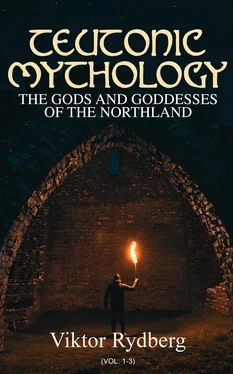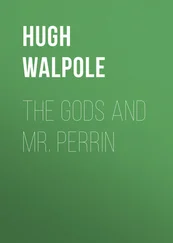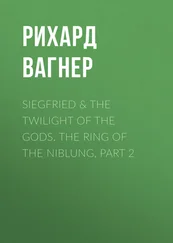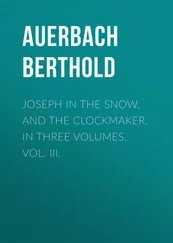Viktor Rydberg - Teutonic Mythology - The Gods and Goddesses of the Northland (Vol. 1-3)
Здесь есть возможность читать онлайн «Viktor Rydberg - Teutonic Mythology - The Gods and Goddesses of the Northland (Vol. 1-3)» — ознакомительный отрывок электронной книги совершенно бесплатно, а после прочтения отрывка купить полную версию. В некоторых случаях можно слушать аудио, скачать через торрент в формате fb2 и присутствует краткое содержание. Жанр: unrecognised, на английском языке. Описание произведения, (предисловие) а так же отзывы посетителей доступны на портале библиотеки ЛибКат.
- Название:Teutonic Mythology: The Gods and Goddesses of the Northland (Vol. 1-3)
- Автор:
- Жанр:
- Год:неизвестен
- ISBN:нет данных
- Рейтинг книги:4 / 5. Голосов: 1
-
Избранное:Добавить в избранное
- Отзывы:
-
Ваша оценка:
- 80
- 1
- 2
- 3
- 4
- 5
Teutonic Mythology: The Gods and Goddesses of the Northland (Vol. 1-3): краткое содержание, описание и аннотация
Предлагаем к чтению аннотацию, описание, краткое содержание или предисловие (зависит от того, что написал сам автор книги «Teutonic Mythology: The Gods and Goddesses of the Northland (Vol. 1-3)»). Если вы не нашли необходимую информацию о книге — напишите в комментариях, мы постараемся отыскать её.
One of Rydberg's mythological theories developed in this book is that of a vast World Mill which rotates the heavens, which he believed was an integral part of Old Norse mythic cosmology.
Teutonic Mythology: The Gods and Goddesses of the Northland (Vol. 1-3) — читать онлайн ознакомительный отрывок
Ниже представлен текст книги, разбитый по страницам. Система сохранения места последней прочитанной страницы, позволяет с удобством читать онлайн бесплатно книгу «Teutonic Mythology: The Gods and Goddesses of the Northland (Vol. 1-3)», без необходимости каждый раз заново искать на чём Вы остановились. Поставьте закладку, и сможете в любой момент перейти на страницу, на которой закончили чтение.
Интервал:
Закладка:
Thus it is proved that the god who is the father of the Teutonic patriarch Mannus is himself the son of Frigg, the goddess of earth, and must, according to the mythic records at hand, be either Thor or Balder. The name given him by Tacitus, Tuisco , does not determine which of the two. Tuisco has the form of a patronymic adjective, and reappears in the Norse Tívi , an old name of Odin, related to Dios divus , and devas , from which all the sons of Odin and gods of Asgard received the epithet tívar . But in the songs learned by Saxo in regard to the northern race-patriarch and his divine father, his place is occupied by Thor, not by Balder, and "Jord's son" is in Norse poetry an epithet particularly applied to Thor.
Mannus has three sons. So has Halfdan. While Mannus has a son Ingævo , Halfdan has a stepson Yngve, Inge (Svipdag). The second son of Mannus is named Hermio. Halfdan's son with Groa is called Gudhormr . The second part of this name has, as Jessen has already pointed out, nothing to do with ormr . It may be that the name should be divided Gudhormr , and that hormr should be referred to Hermio . Mannus' third son is Istævo . The Celtic scholar Zeuss has connected this name with that of the Gothic (more properly Vandal) heroic race Azdingi, and Grimm has again connected Azdigni with Hazdiggo ( Haddingr ). Halfdan's third son is in Saxo called Hadingus. Whether the comparisons made by Zeuss and Grimm are to the point or not (see further, No. 43) makes but little difference here. It nevertheless remains as a result of the investigation that all is related by Tacitus about the Teutonic patriarch Mannus has its counterpart in the question concerning Halfdan, and that both in the myths occupy precisely the same place as sons of a god and as founders of Teutonic tribes and royal families. The pedigrees are:
Tacitus. Norse documents.Tivi and the goddess Jord. Tivi=Odin and the goddess | Jord. | | Tivi's son (Tiusco). Tivi's son Thor. | | Mannus, progenitor of the Halfdan, progenitor of the Teutonic tribes. royal families. +————+————+ +————+————+ | | | | | | Ingævo. Hermio. Istævo. Yngve. Gudhormr. Hadding.
26.
THE SACRED RUNES LEARNED FROM HEIMDAL.
Table of Contents
The mythic ancient history of the human race and of the Teutons may, in accordance with the analysis above given, be divided into the following epochs:—(1) From Ask and Ernbla's creation until Heimdal's arrival; (2) from Heimdal's arrival until his departure; (3) the age of Skjold-Borgar; (4) Halfdan's time; (5) The time of Halfdan's sons.
And now we will discuss the events of the last three epochs.
In the days of Borgar the moral condition of men grows worse, and an event in nature takes place threatening at least the northern part of the Teutonic world with destruction. The myth gives the causes of both these phenomena.
The moral degradation has its cause, if not wholly, yet for the greater part, in the activity among men of a female being from the giant world. Through her men become acquainted with the black art, the evil art of sorcery, which is the opposite of the wisdom drawn from Mimer's holy fountain, the knowledge of runes, and acquaintance with the application of nature's secret forces for good ends (see Nos. 34, 35).
The sacred knowledge of runes, the "fimbul-songs," the white art, was, according to the myth, originally in the possession of Mimer. Still he did not have it of himself, but got it from the subterranean fountain, which he guarded beneath the middle root of the world-tree (see No. 63)—a fountain whose veins, together with the deepest root of the world-tree, extends to a depth which not even Odin's thought can penerate (Havam., 138). By self-sacrifice in his youth Odin received from Bestla's brother (Mimer; see No. 88) a drink from the precious liquor of this fountain and nine fimbul-songs (Havam., 140; cp. Sigrdr., 14), which were the basis of the divine magic of the application of the power of the word and of the rune over spiritual and natural forces, in prayer, in sacrifices and in other religious acts, in investigations, in the practical affairs of life, in peace and in war (Havam., 144 ff.; Sigrdr., 6 ff.). The character and purpose of these songs are clear from the fact that at the head is placed "help's fimbul-song," which is able to allay sorrow and cure diseases (Havam., 146).
In the hands of Odin they are a means for the protection of the power of the Asa-gods, and enable them to assist their worshippers in danger and distress. To these belong the fimbul-song of the runes of victory ; and it is of no little interest that we, in Havamál, 156, find what Tacitus tells about the barditus of the Germans, the shield-song with which they went to meet their foes—a song which Ammianus Paulus himself has heard, and of which he gives a vivid description. When the Teutonic forces advanced to battle the warriors raised their shields up to a level with the upper lip, so that the round of the shield formed a sort of sounding-board for their song. This began in a low voice and preserved its subdued colour, but the sound gradually increased, and at a distance it resembled the roar of the breakers of the sea. Tacitus says that the Teutons predicted the result of the battle from the impression the song as a whole made upon themselves: it might sound in their ears in such a manner that they thereby became more terrible to their enemies, or in such a manner that they were overcome by despair. The above-mentioned strophe of Havamál gives us an explanation of this: the warriors were roused to confidence if they, in the harmony of the subdued song increasing in volume, seemed to perceive Valfather's voice blended with their own. The strophe makes Odin say: Ef ec scal til orrostu leitha langvini, undir randir ec gel, en their meth ríki fara heilir hildar til, heilir hildi frá —"If I am to lead those to battle whom I have long held in friendship, then I sing under their shields. With success they go to the conflict, and successfully they go out of it." Völuspa also refers to the shield-song in 47, where it makes the storm-giant, Hrymr , advancing against the gods, "lift his shield before him" ( hefiz lind fyrir ), an expression which certainly has another significance than that of unnecessarily pointing out that he has a shield for protection. The runes of victory were able to arrest weapons in their flight and to make those whom Odin loved proof against sword-edge and safe against ambush (Havam., 148, 150). Certain kinds of runes were regarded as producing victory and were carved on the hilt and on the blade of the sword, and while they were carved Tyr's name was twice named (Sigrdr., 6).
Another class of runes ( brimrúnar , Sigrdr., 10; Havam., 150) controlled the elements, purified the air from evil beings (Havm., 155), gave power over wind and waves for good purposes—as, for instance, when sailors in distress were to be rescued—or power over the flames when they threatened to destroy human dwellings (Havam., 152). A third kind of runes ( málrúnar ) gave speech to the mute and speechless, even to those whose lips were sealed in death (see No. 70). A fourth kind of runes could free the limbs from bonds (Havam., 149). A fifth kind of runes protected against witchcraft (Havam., 151). A sixth kind of runes ( ölrúnar ) takes the strength from the love-potion prepared by another man's wife, and from every treachery mingled therein (Sigrdr., 7, 8). A seventh kind ( bjargrúnar and limrúnar ) helps in childbirth and heals wounds. An eighth kind gives wisdom and knowledge ( hugrúnar , Sigrdr., 13; cp. Havam., 159). A ninth kind extinguishes enmity and hate, and produces friendship and love (Havam., 153, 161). Of great value, and a great honour to kings and chiefs, was the possession of healing runes and healing hands; and that certain noble-born families inherited the power of these runes was a belief which has been handed down even to our time. There is a distinct consciousness that the runes of this kind were a gift of the blithe gods. In a strophe, which sounds as if it were taken from an ancient hymn, the gods are beseeched for runes of wisdom and healing: "Hail to the gods! Hail to the goddesses! Hail to the bounteous Earth (the goddess Jord). Words and wisdom give unto us, and healing hands while we live!" (Sigrdr., 4).
Читать дальшеИнтервал:
Закладка:
Похожие книги на «Teutonic Mythology: The Gods and Goddesses of the Northland (Vol. 1-3)»
Представляем Вашему вниманию похожие книги на «Teutonic Mythology: The Gods and Goddesses of the Northland (Vol. 1-3)» списком для выбора. Мы отобрали схожую по названию и смыслу литературу в надежде предоставить читателям больше вариантов отыскать новые, интересные, ещё непрочитанные произведения.
Обсуждение, отзывы о книге «Teutonic Mythology: The Gods and Goddesses of the Northland (Vol. 1-3)» и просто собственные мнения читателей. Оставьте ваши комментарии, напишите, что Вы думаете о произведении, его смысле или главных героях. Укажите что конкретно понравилось, а что нет, и почему Вы так считаете.











